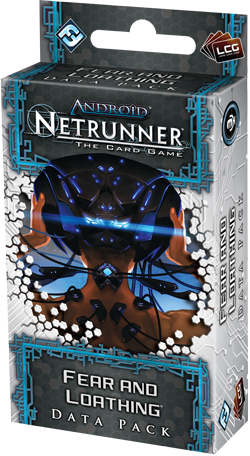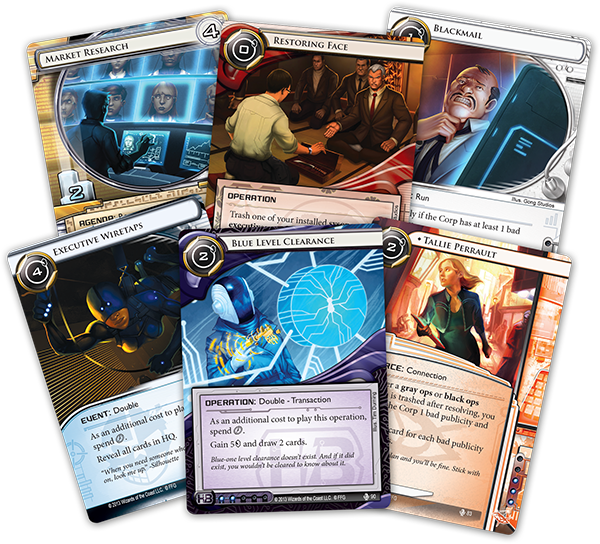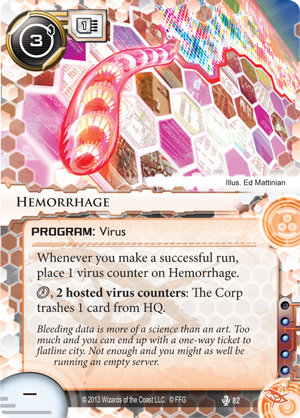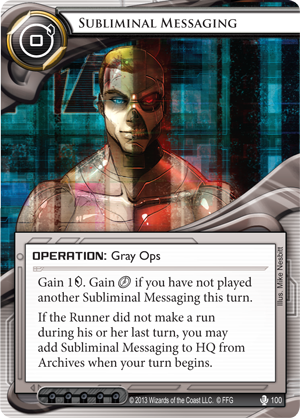
Coverups and Cybercrime
Fear and Loathing Is Now Available for Android: Netrunner

“Subliminal adverts are illegal, but that hasn’t stopped Haas-Bioroid from layering encoded bursts throughout the entirety of their Rex campaign.”
–Tallie Perrault
Information is power. And it’s time to start flexing that power. Fear and Loathing, the penultimate Data Pack in the Spin Cycle for Android: Netrunner, is now available at your local retailer!
Its sixty cards (three copies each of twenty different cards) explore and expose the vertiginous disconnect between the executives who run the game’s ultra-rich megacorporations from the penthouse suites of their gleaming headquarters and the huddled masses of humanity who live within their shadows. On either end of this divide, you’ll find plenty of new tools, tricks, codes, and contacts to help you expose corporate secrets or bury them in servers so deeply hidden that accessing them would require a level of clearance so rare that it’s doubtful it even exists.
Meanwhile, Fear and Loathing continues to amplify the Spin Cycle’s PR campaigns and grassroots politicking. Jinteki gains new means to restore any lost face, and the Weyland Consortium rids itself of harmful data leaks, while NBN’s market research helps it better match its messages to its key demographics. Still, Runners press deeper for new dirt they can use to begin new narratives, exposing corporate secrets and passing them along to activists like Tallie Perrault (Fear and Loathing, 83) or using them against Corporate stooges in efforts to gain and sell even more valuable information.

The War on HQ
Two new cards from Fear and Loathing heat up the contest for control of the Corp’s HQ.
- Hemorrhage (Fear and Loathing, 82) provides the game’s Anarchs with both a means of applying timely pressure to HQ and of ensuring that they’ll find a steady stream of cards headed toward Archives, the server they typically prefer to run.
- Subliminal Messaging (Fear and Loathing, 100), on the other hand, provides the Corp another means of accelerating its economy and of limiting the effectiveness of runs against HQ, as well as cards like Hemorrhage.
 Hemorrhage is an intriguing tool, but using it properly requires a good degree of advance planning. For one click and the expenditure of two hosted virus counters, which you gain by making successful runs, you can force the Corp to trash a card from HQ. By using Hemorrhage, you can limit the Corp’s available options, as well as force cards into Archives ahead of a run on that server.
Hemorrhage is an intriguing tool, but using it properly requires a good degree of advance planning. For one click and the expenditure of two hosted virus counters, which you gain by making successful runs, you can force the Corp to trash a card from HQ. By using Hemorrhage, you can limit the Corp’s available options, as well as force cards into Archives ahead of a run on that server.
Still, Anarchs can already apply a great deal of pressure on Corporate HQ through the use of Nerve Agent (Cyber Exodus, 41) or by spending some of their influence to purchase an HQ Interface (Humanity’s Shadow, 85). Furthermore, both of these tools function while you run on HQ, and running is the soul of the Runner’s game.
So how does a card like Hemorrhage fit into the game? It doesn’t directly help you to access a card, and it comes with the catch that the Corp player gets to choose which card he trashes. Furthermore, it requires runs to fuel, but activating it results in a click not spent on a run.
The answer is that Hemorrhage opens up a number of Anarch mind games that didn’t previously exist. Sure, the Corp player gets to choose which card he trashes, but if he has to trash one of just two cards, will he trash the agenda, or the other card? And how many cards does the Corp want to keep in hand, then, if you can rip that hand apart at any time? Will you force the Corp player to install cards faster than he can realistically protect them? Will you bait the Corp into spending three clicks on clearing virus counters, just to earn four back the next turn by making four successful runs?
Managing the ebb and flow of the game’s struggles is as much a part of the game as the rig that lets you win them.
 Meanwhile, Subliminal Messaging provides the Corp with a response to Hemorrhage and other cards that place pressure on its HQ.
Meanwhile, Subliminal Messaging provides the Corp with a response to Hemorrhage and other cards that place pressure on its HQ.
In its simplest use, Subliminal Messaging plays to gain a credit. If this was all the card did, it would be fairly worthless, though, since that economy of one click to one credit already exists within the game’s core mechanics. Cards like Gorman Drip v1 (Opening Moves, 5) might provide a very limited utility to such an effect, but not enough to prevent the card from becoming “binder fodder.”
Instead, Subliminal Messaging rewards players with some secondary abilities. The first and foremost of these is the ability to gain a click when you play the card if you haven’t already played another copy of Subliminal Messaging in the turn. Free credits? Why, yes, thank you.
It gets better, though, since if you can encourage the Runner to sit back on his heels for a turn, you can add Subliminal Messaging to HQ from Archives:
“If the Runner did not make a run during his or her last turn, you may add Subliminal Messaging to HQ from Archives when your turn begins.”
It’s worth noting that if you have multiple copies of Subliminal Messaging, this trigger works for each of them, separately, meaning that you can retrieve them all to hand after the Runner spends a turn tinkering with his rig, rather than running. While this can set you up for three turns of free credits, it’s possibly more important because it can flood your HQ with cards that the Runner can’t pay to trash during runs, limiting his odds of stealing a single agenda tucked into a five-card HQ. In this sense, Subliminal Messaging’s secondary ability serves more as a three-card, zero-click, draw-based effect than as an action-neutral, credit-based effect, and three cards for zero clicks is good. Very, very good.
Make Them Fear You
Will you use your Subliminal Messaging to make the masses love you? Or will you use it to make the game’s Runners fear you? Hemorrhage, Subliminal Messaging, and Tallie Perrault are just a few of the cards in Fear and Loathing that permit powerful new ways to manipulate data.
Head to your local retailer today. Fear and Loathing is now available!
…
